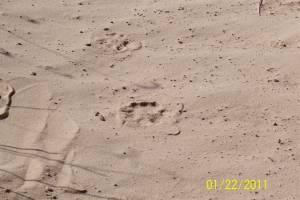In January we had the fortune to receive several tracking and trailing classes with professional tracker Casey McFarland. Some of our volunteers and several other interested parties came out to learn good trailing basics from an excellent teacher. After finding a good, solid, lone mule deer trail, we followed it for the better part of the day, learning to keep our heads up, looking out in front of us as far as we could see visible tracks. Beyond where we could actually see the tracks, 10, 20, sometimes 30 ft. away, we would then look for the next track “trap”, usually an open, silty area that would for sure show a track if the animal came that way. After identifying traps, we would then look for “gateways”, possible routes the deer could take across the land. Combining all 3 of these techniques, head up, traps, and gateways, we would be able to “flow” across the land, checking the tracks often to make sure we were still following the same deer, and it was still going the same direction.
Tracking and Trailing classes
February 8, 2011









Comments on: "Tracking and Trailing classes" (5)
So nice to read about it and imagine you all spending the better part of the day in league with one animal.
Yes, its good to know that there are still places you can go to experience kinship with the land.
Sounds like an interesting and educational day! I didn’t know about track traps, but I’d like to see one. Thanks for sharing!
Track traps are just areas of (usually) bare ground which registers tracks well, like soft, silty areas, as opposed to grassy or rocky areas, or where the ground is just hard or frozen.
This looks like fun! I often teach tracking and there is a lot to consider. I liked the heads up, although you can see a lot further out where you live then we can in our dense forests.
This is a very interesting website. I’ll be returning to see what’s next!